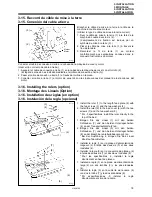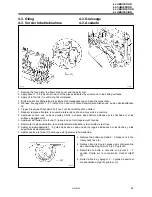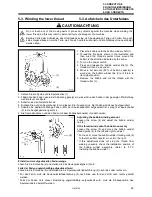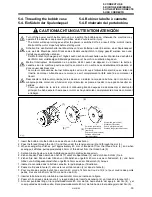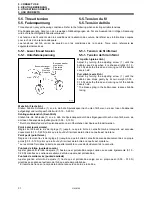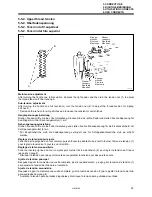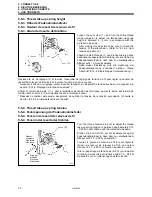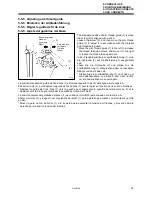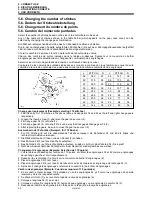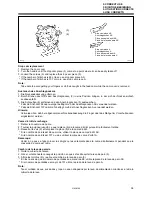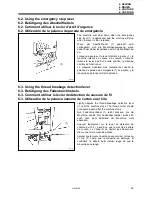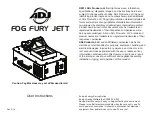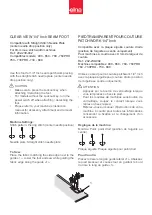
5. CORRECT USE
5. RICHTIGE BEDIENUNG
5. UTILISATION CORRECTE
5. USO CORRECTO
HM-8180
30
5-4. Threading the bobbin case
5-4. Bobiner la boîte à cannette
5-4. Einfädeln der Spulenkapsel
5-4. Enhebrado del portabobina
CAUTION/ACHTUNG/ATTENTION/ATENCIÓN
Turn off the power switch before removing or inserting the bobbin case, otherwise the machine may
operate if the treadle is depressed by mistake, which could result in injury.
* The motor will keep turning even after the power is switched off as a result of the motor’s inertia.
Wait until the motor stops fully before starting work.
Schalten Sie den Netzschalter der Maschine vor dem Entfernen oder Einsetzen einer Squlenkapsel
aus, weil die Maschine durch Drücken des Pedals unabsichtlich in Gang gesetzt werden kann und
Verletzungen entstehen können.
* Der Motor dreht sich wegen der Trägheit auch nach dem Ausschalten weiter. Warten Sie deshalb bis
der Motor zum vollständigen Stillstand gekommen ist, bevor Sie zu arbeiten beginnen.
Mettre l’interrupteur d’alimentation en position d’arrêt avant de déposer ou d’inserer la boîte à
canette, sinon la machine pourra se mettre en marche si on enfonce accidentellement la pédale, et
donc causer des blessures.
* Le moteur continuera de tourner même après qu’on ait coupé l’alimentation électrique en raison de
l’inertie du moteur. Attendre que le moteur se soit complètement arrêté avant de commencer le
travail.
Desconectar el interruptor principal antes de sacar o instalar la caja de la bobina, de lo contrario la
máquina podría comenzar a funcionar si por descuido se pisara el pedal, lo que podría resultar en
heridas.
* Como resultado de la inercia el motor continuará girando después de desconectar el interruptor
principal. Se debe esperar hasta que el motor se haya detenido completamente antes de comenzar
a trabajar.
1. Insert the bobbin into the bobbin case as shown in the illustration.
2. Pass the thread through the slot (1) and then under the tension spring (2) and through the slot (3).
3. When sewing whip stitches, pull approximately 40 mm of thread out from the thread hole (4), and when
sewing purl stitches, pull approximately 40 mm of thread out from the thread hole (5).
1. Setzen Sie die Spule wie in der Abbildung gezeigt in die Spulenkapsel ein.
2. Ziehen Sie den Faden durch den Schlitz (1) unter die Spannfeder (2) und durch den Schlitz (3) ein.
3. Ziehen Sie den Faden beim Nähen von Webstichen ungefähr 40 mm aus dem Fadenloch (4) und beim
Nähen von Schlingenkantenstichen ungefähr 40 mm aus dem Fadenloch (5) heraus.
1. Insérez la cannette dans la boîte à cannette, tel qu’indiqué sur l’liiustration.
2. Passez le fil dans la fente (1) et sous le ressort de tension (2) et dans la fente (3).
3. Pour coudre des points à plat, tirez environ 40 mm de fil hors du trou de fil (4) et pour coudre des points
perlés, tirez environ 40 mm de fil hors du trou de fil (5).
1. Insertar la bobina en el portabobina. Insertarlo tal como se indica en la figura.
2. Pasar el hilo a través de la ranura (1) y luego debajo del resorte de tensión (2) y a través de la ranura (3).
3. Al coser puntadas látigo, tirar aproximadamente 40 mm de hilo hacia afuera del agujero del hilo (4), y al
coser puntadas de malla vuelta, tirar aproximadamente 40 mm de hilo hacia afuera del agujero del hilo (5).
(2)
(3)
(5)
(4)
(1)
Purl stitch (seal stitch)
Schlingenkantenstich
(seal-stich)
Point perlé (point couture)
Puntada malla vuelta
(puntada sellada)
Whip stitch (plain stitch)
Webstich (Flachstich)
Point à plat (point simple)
Puntada látigo (puntada común)
1278Q



